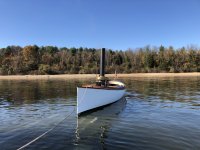Splash report:
Weather was a fantastic 75 degrees and water temperature was around 55. Docks were taken out this past week, but there were plenty of boats still using the lake as it has been dropped to its winter level 5' lower than normal. Lake of choice: Blue Marsh in Reading, PA. This is the body of water I am most familiar boating on and so rather than having unknowns of the water, it was best to know it like the back of my hand. Video at the end.
Light match:
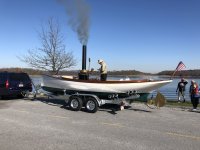
The crowds start forming. It became very apparent that the same questions are asked over and over again, so new viewers were greeted with "It burns wood, we started building it 9 years ago, this is the first launch, and yes we built everything but the hull."
Steam Master is ready to go. Launch time:
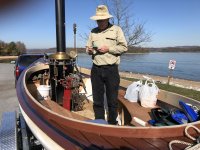
Checking for leaks from the propeller shaft seal as well as the rudder, no water. Yes!
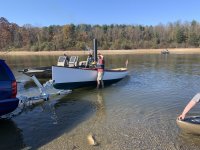
We then pulled the boat back out of the water to load it down with 5 adults and 2 children. With no docks, I tied the boat off to the shore and moved the trailer, returning to wade into about 2 feet deep water and climbing onboard. Not too bad.
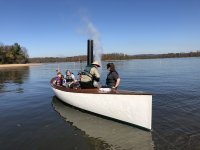
As we put it in reverse and pulled away, the temporary tiller arm snapped, leaving me with the bronze top fitting that is about 8 inches long. There is a lot of force put on that tiller arm especially in reverse, so I sort of laid back the whole trip keeping the boat going by holding course with the small tiller arm. It is at this point that I was very thankful that I knew the lake very well since my visibility was limited.
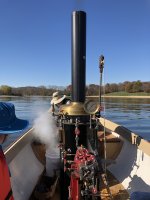
There is an island in the middle of this lake and today's goal was to circumnavigate this. The loop itself is about 2 miles, and around the 1 mile point, we ran into issue #2: The injector was not adding water to the boiler. For those of you that don't know a bunch about steam boilers, there is a sheet of steel on top of the fire that must be covered with water at all times. Once this is not covered with water the boiler can explode. If we can't add water to the boiler, it is time to break out the paddles. So taking a 15 minute pause we had some lunch while the injector system cooled down and I quietly contemplated the best method of rowing a 24' vessel with a limited-use tiller. After eating we dumped a bunch of the ice from the cooler into the intake water bucket (white bucket on left in above photo) and the injector magically started working. We now needed to quickly build steam pressure back up and finish the second half of the trip before we ran out of ice to cool the water.
View over aft of boat while enjoying lunch and contemplating how we were getting back to the dock:
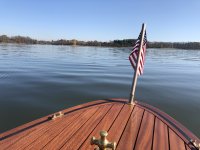
View of passengers on the boat with my spot in the bottom left. We could have fit an additional adult up front and probably another one in the rear.
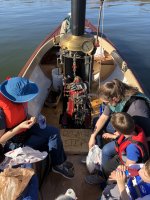
After building back pressure in a few minutes we were able to round the island and make a B-line for the ramp. There were powerboats around us that if we had a problem one could tow us back in, but I really didn't feel like having our first trip ever end in needing a tow. We made it back to the boat ramp and let the small amount of current drift us in the last 40 feet until I jumped off the front to once again wade in the water and move the boat to a holding place until it I could get the trailer.
When building the fore and aft decks I never really planned on walking or otherwise sitting on them, however to get in with no docks, I got to ride on the bow as we drifted closer:
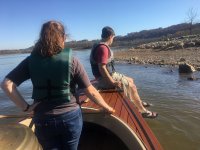
One of today's goals was to see how well the boat lined up on the trailer as I retrieved it, so we put it on the trailer once to get riders off and then I launched the boat again to take the teaser picture above. I was very happy that all the modifications we made to rollers resulted in perfect alignment both times.
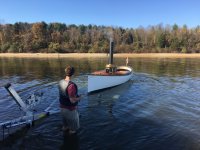
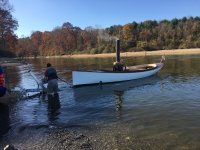
We were able to do about 5.5 knots although we didn't open it up the entire way. I was also hoping to have an ideal RPM for you, but due to my limited mobility holding the tiller and other reasons, we weren't quite able to run all the tests I would have liked. We were also very pleased that the waterline provided from the manufacturer was very accurate to how it actually sat in the water - even with a full load of people onboard.
And now after that novel, here's the part you have actually been waiting for: the video. Just note that if you look at the steam gauge, it is incorrect. On Friday something went wrong with it and it wasn't reading correctly, so at various points today it was incorrect as well. The boiler cannot reach the indicated 300psi, and we are able to tell about how much steam is in by blowing the whistle. Additionally, the safety valve lets off extra steam if it gets too high pressure so we never really were in danger of over-pressure... just not having correct information.
Thanks for everyone who has chimed in over the past 9 years to watch this build. This thread is not done, there are still many things to finish like the interior, the steam condenser, and the canopy which will continue to be chronicled on here. Make sure to keep checking back for updates as we tweak and improve the Steam Launch Merrilee!





















